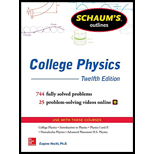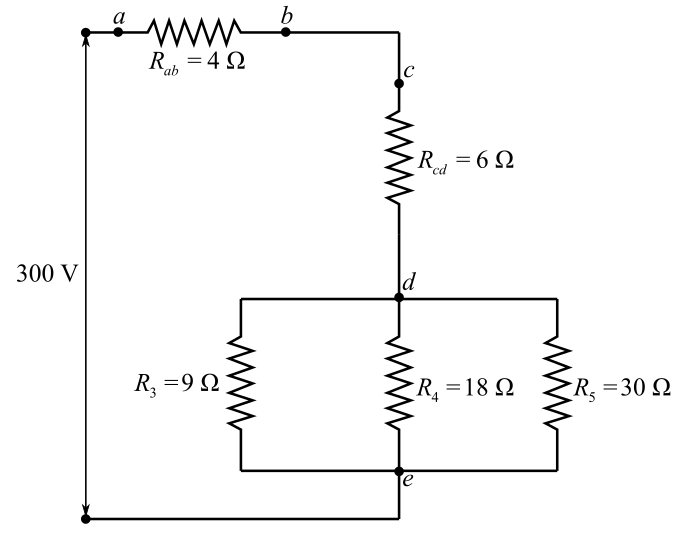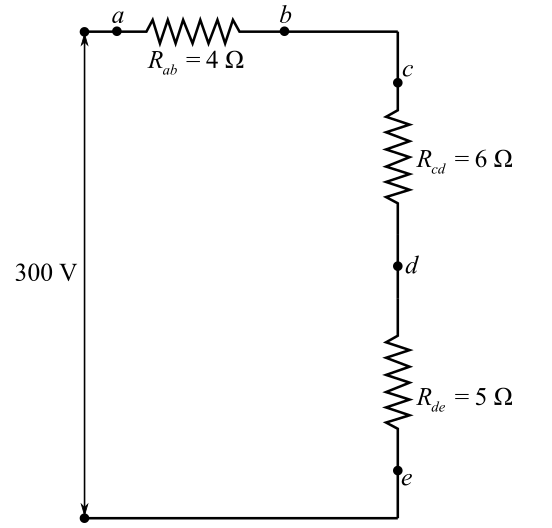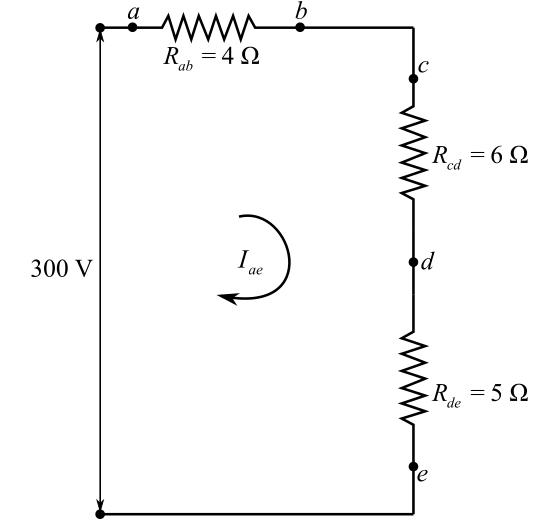
Concept explainers
For the circuit shown in Fig. 28-14, find (a) its equivalent resistance; (b) the current drawn from the power source; (c) the potential differences across ab, cd, and de; (d) the current in each resistor.
![Chapter 28, Problem 31SP, 28.31 [II] For the circuit shown in Fig. 28-14, find (a) its equivalent resistance; (b) the current](https://content.bartleby.com/tbms-images/9781259587399/Chapter-28/images/87399-28-31sp-question-digital_image79.png)
Fig. 28-14
(a)
The net resistance across the circuit provided in the figure 28-14 in the textbook.
Answer to Problem 31SP
Solution:
Explanation of Solution
Given data:
The resistances
The resistances
The resistance across circuit
The voltage across the terminal
Formula used:
The expression for the equivalent resistance in series is written as
Here,
The expression for the equivalent resistance in parallel is written as
Here,
Explanation:
Refer to the fig. 28-14from the textbook.
Draw the circuit diagram:

Since, the resistance
Write the expression for the resistances across
Here,
Substitute
Solve for
Modify the above drawn circuit diagram by using

Understand that the resistors
Here,
Substitute
Here,
Redraw the modified circuit diagram by using the calculated equivalent resistances across the nodes:

Since, all the resisters in the above diagram arein series combination.
Write the expression for the total resistance of the equivalent resistances across
Here,
Substitute
Conclusion:
The net resistance across the point
(b)
The current drawn from the source if the voltage across the circuit is
Answer to Problem 31SP
Solution:
Explanation of Solution
Given data:
Voltage across the circuit is
Formula used:
The expression for theOhm`s law if net current
Explanation:
Redraw the equivalent circuit diagram:

In the above diagram,
Rewrite the expression of the Ohm`s law for the net current across circuit
Here,
Rearrange for
Here,
Substitute
Conclusion:
Therefore, the current drawn from the source is
(c)
The voltage difference across circuits
Answer to Problem 31SP
Solution:
Explanation of Solution
Given data:
The current across
The resistances of the resistor are provided in the figure as
Formula used:
The expression for the net Voltage
Explanation:
The current in the series combination of circuits
Write the expression for the voltage across circuit
Here,
Substitute
Write the expression for the voltage across circuit
Here,
Substitute
Write the expression for the voltage across circuit
Here,
Substitute
Conclusion:
The voltages across circuits
(d)
The current across each resistor if the voltage and current across each circuit are known.
Answer to Problem 31SP
Solution:
Explanation of Solution
Given data:
The voltage across the circuit
The voltage across the circuit
The voltage across the circuit
The current across the circuit
Formula used:
The expression for the net voltage
Explanation:
In this, wewill use the fact that voltage across each resistor in a parallel combination of resistors remains same.
According to the Ohm’s law, the current across the
Rearrange for
Here
Substitute
The voltage across the parallel combination of resistance
Write the expression for the current across
Rearrange for
Here,
Substitute
Write the expression for the current across
Rearrange for
Here,
Substitute
The voltage across the parallel combination of resistors
Write the expression for the current across
Rearrange for
Here,
Substitute
Write the expression for the current across
Rearrange for
Here,
Substitute
Write the expression for the current across
Rearrange for
Here,
Substitute
Conclusion:
The current across the
Want to see more full solutions like this?
Chapter 28 Solutions
Schaum's Outline of College Physics, Twelfth Edition (Schaum's Outlines)
- 3.37(a) Five free electrons exist in a three-dimensional infinite potential well with all three widths equal to \( a = 12 \, \text{Å} \). Determine the Fermi energy level at \( T = 0 \, \text{K} \). (b) Repeat part (a) for 13 electrons. Book: Semiconductor Physics and Devices 4th ed, NeamanChapter-3Please expert answer only. don't give gpt-generated answers, & please clear the concept of quantum states for determining nx, ny, nz to determine E, as I don't have much idea about that topic.arrow_forwardNo chatgpt pls will upvotearrow_forwardUse the following information to answer the next question. Two mirrors meet an angle, a, of 105°. A ray of light is incident upon mirror A at an angle, i, of 42°. The ray of light reflects off mirror B and then enters water, as shown below: Incident ray at A Note: This diagram is not to scale. a Air (n = 1.00) Water (n = 1.34) 1) Determine the angle of refraction of the ray of light in the water. Barrow_forward
- Hi can u please solvearrow_forward6. Bending a lens in OpticStudio or OSLO. In either package, create a BK7 singlet lens of 10 mm semi-diameter and with 10 mm thickness. Set the wavelength to the (default) 0.55 microns and a single on-axis field point at infinite object distance. Set the image distance to 200 mm. Make the first surface the stop insure that the lens is fully filled (that is, that the entrance beam has a radius of 10 mm). Use the lens-maker's equation to calculate initial glass curvatures assuming you want a symmetric, bi-convex lens with an effective focal length of 200 mm. Get this working and examine the RMS spot size using the "Text" tab of the Spot Diagram analysis tab (OpticStudio) or the Spd command of the text widnow (OSLO). You should find the lens is far from diffraction limited, with a spot size of more than 100 microns. Now let's optimize this lens. In OpticStudio, create a default merit function optimizing on spot size.Then insert one extra line at the top of the merit function. Assign the…arrow_forwardNo chatgpt pls will upvote Already got wrong chatgpt answer .arrow_forward
- Use the following information to answer the next question. Two mirrors meet an angle, a, of 105°. A ray of light is incident upon mirror A at an angle, i, of 42°. The ray of light reflects off mirror B and then enters water, as shown below: A Incident ray at A Note: This diagram is not to scale. Air (n = 1.00) Water (n = 1.34) Barrow_forwardUse the following information to answer the next question. Two mirrors meet an angle, a, of 105°. A ray of light is incident upon mirror A at an angle, i, of 42°. The ray of light reflects off mirror B and then enters water, as shown below: A Incident ray at A Note: This diagram is not to scale. Air (n = 1.00) Water (n = 1.34) Barrow_forwardGood explanation it sure experts solve it.arrow_forward
- No chatgpt pls will upvote Asaparrow_forwardA satellite has a mass of 100kg and is located at 2.00 x 10^6 m above the surface of the earth. a) What is the potential energy associated with the satellite at this loction? b) What is the magnitude of the gravitational force on the satellite?arrow_forwardNo chatgpt pls will upvotearrow_forward
 College PhysicsPhysicsISBN:9781938168000Author:Paul Peter Urone, Roger HinrichsPublisher:OpenStax College
College PhysicsPhysicsISBN:9781938168000Author:Paul Peter Urone, Roger HinrichsPublisher:OpenStax College Principles of Physics: A Calculus-Based TextPhysicsISBN:9781133104261Author:Raymond A. Serway, John W. JewettPublisher:Cengage Learning
Principles of Physics: A Calculus-Based TextPhysicsISBN:9781133104261Author:Raymond A. Serway, John W. JewettPublisher:Cengage Learning
 Glencoe Physics: Principles and Problems, Student...PhysicsISBN:9780078807213Author:Paul W. ZitzewitzPublisher:Glencoe/McGraw-Hill
Glencoe Physics: Principles and Problems, Student...PhysicsISBN:9780078807213Author:Paul W. ZitzewitzPublisher:Glencoe/McGraw-Hill College PhysicsPhysicsISBN:9781285737027Author:Raymond A. Serway, Chris VuillePublisher:Cengage Learning
College PhysicsPhysicsISBN:9781285737027Author:Raymond A. Serway, Chris VuillePublisher:Cengage Learning College PhysicsPhysicsISBN:9781305952300Author:Raymond A. Serway, Chris VuillePublisher:Cengage Learning
College PhysicsPhysicsISBN:9781305952300Author:Raymond A. Serway, Chris VuillePublisher:Cengage Learning





